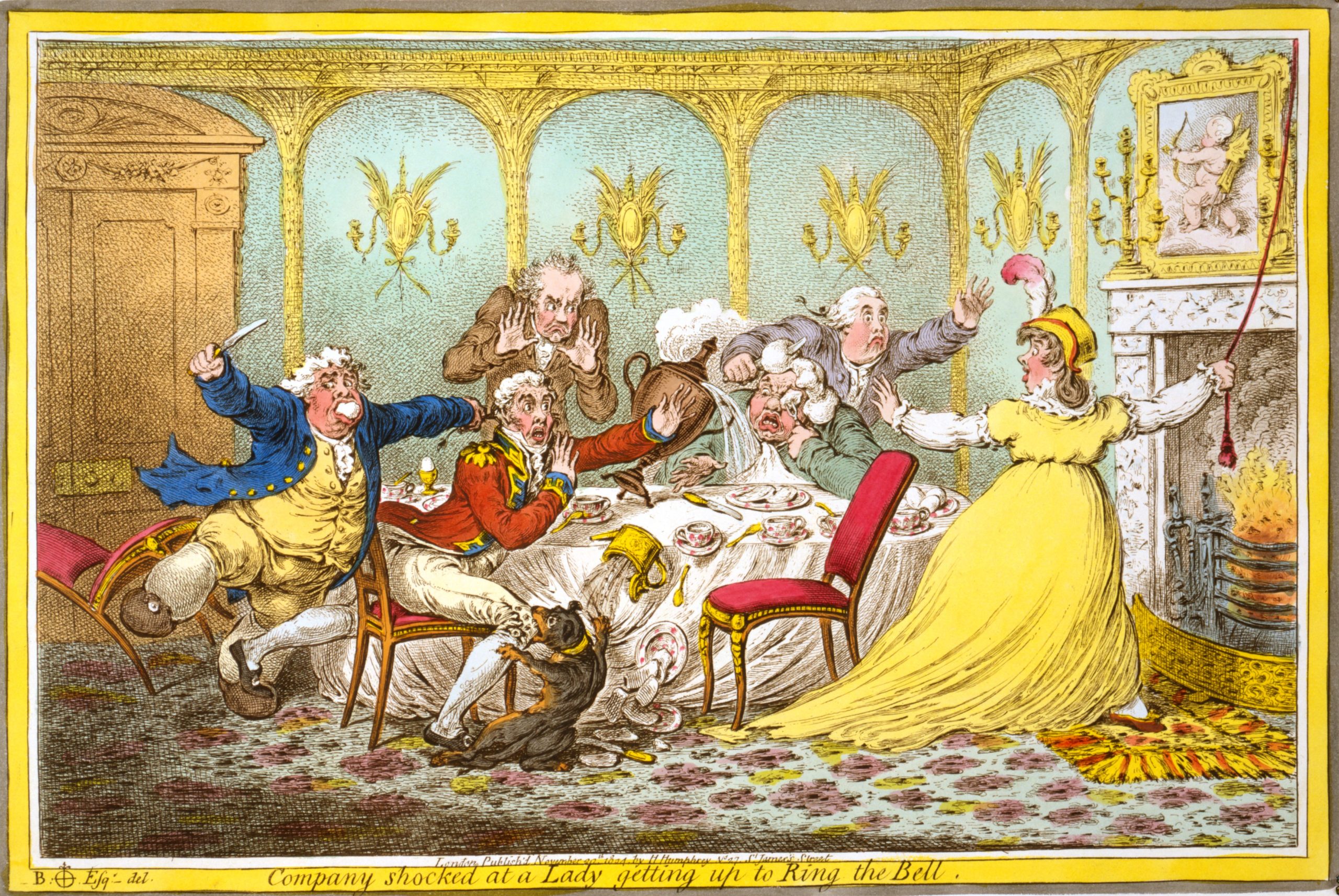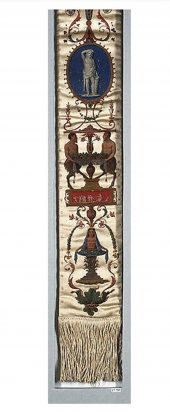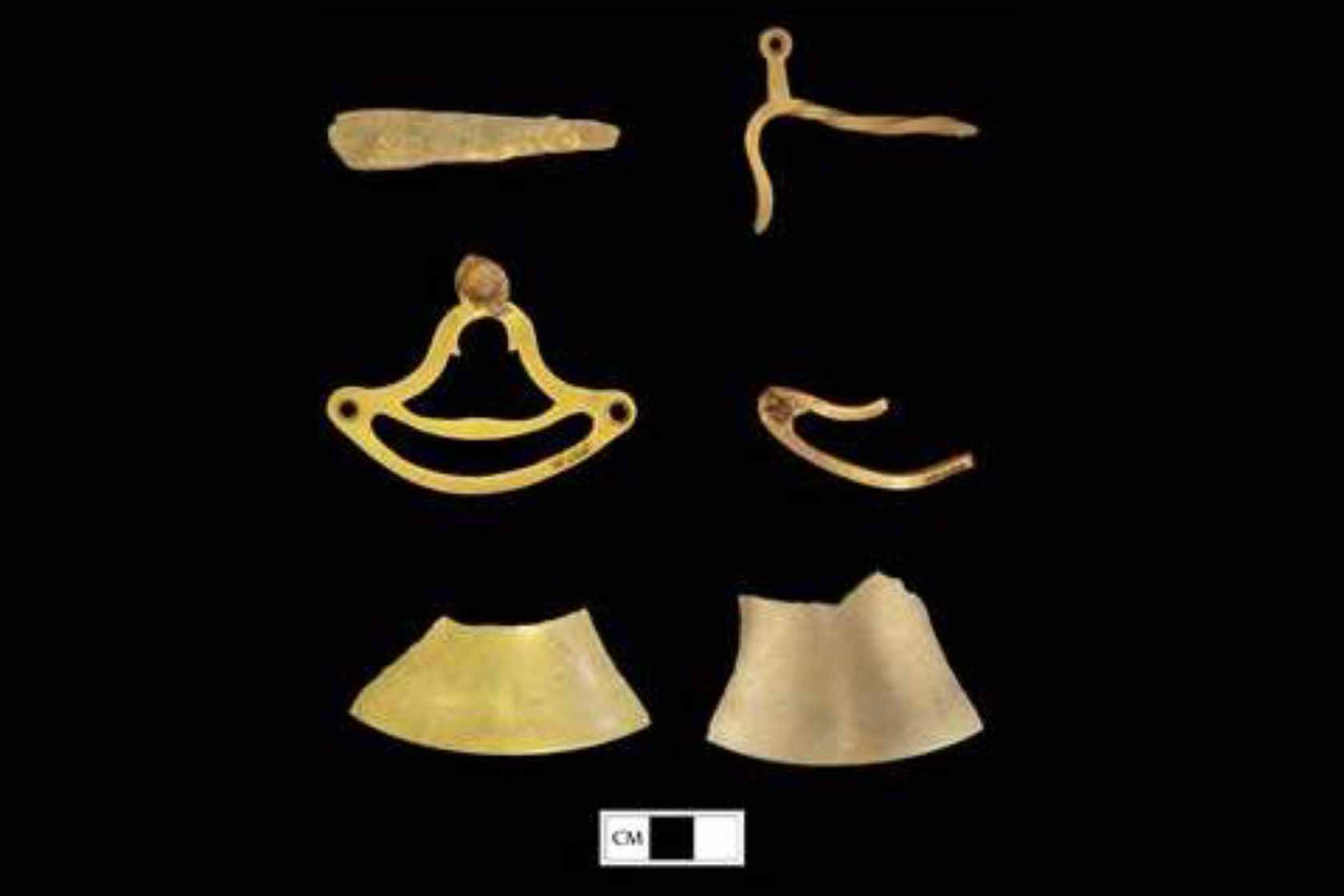Archaeology Blog
Servant Bells at Poplar Forest
Servant bells, also called house bells, are systems of wire and pulleys that run throughout a building and allow a resident to call for a servant from the far reaches of the building without leaving the room they are in. The earliest record of mounted house bells was in a 1727 inventory of the Great House at Kiveton, seat of the Marquess of Carmarthen (Murdoch 2006).
The eighteenth century marked major cultural changes in aristocratic English household arrangement. The home became a familial sanctuary to which guests were permitted intermittently and in which servants were expected to be invisible (Tuan 1982). With the flood of consumer products into the marketplace in the late 1700s, luxury and consumerism became a visible marker of nobility and success. As a veneer of expensive cultured elegance became inextricably linked to one’s social status, the separation between the servant and master classes within the household became of mounting importance (Crowley 2003).
Prior to mounted bells, masters summoned servants by the ringing of a small hand bell or through vocal summons (Murtha 2010). However, these methods required servants to wait within hearing distance at all times; they could not engage in other chores or activities and still be accessible. House bells provided a more genteel way to request help from servants while simultaneously allowing the servants greater locational flexibility. Instead of coarsely yelling across the halls of his house, an employer could quietly pull a cord to summon his employees, projecting an image of ease and leisure (Crowley 2003).
In the early 1800s, the United States was a young nation with a rising class based on ability and success instead of lineage. The upper echelon of American society was composed of the landed planters and successful businessmen who cemented themselves as elite members of society by emulating their European counterparts. Gentility, refinement, and polite behavior became the way to identify the truly refined members of society (see Figure 1) (Bushman 1992).
Robert Roberts, a black freeman and author of The House Servant’s Directory (1828), outlined servant duties and expectations for how slaves and servants were expected to behave in fine Antebellum households. Under the heading of “Remarks on Answering the Bells”, Roberts wrote: “…lose no time in going to answer it; never wait to finish what you are about, and leave the bell unanswered ; you never should let the bell ring twice if you possibly can avoid it, for it seems to be a great part of negligence in a servant”.
While many plantation homes in the Antebellum South followed their northern and urban neighbors’ example and installed house bells, many slaveowners simply did not see the need to do so. Bell systems in the North were intended to disconnect and depersonalize the relationship between mistress and servant, but racial stigmatization in the nineteenth century had already made the distinction between black and white absolute. Slaves within the home were implicitly understood as inferior by virtue of their race (Weiner 1998). Wealthy slave owners often had several slaves dedicated to serving the white family and more than one observer described such personal enslaved servants as the master’s ‘shadow’. Henry Cogswell Knight traveled extensively throughout Virginia in the 1810s and noted that “Where ever the Virginians go, a slave or two moves behind as their shadow to hold the horses, pull off their boots and pantaloons at bedtime, and, if cold to blow up the fire in their bedrooms with their mouths” (Knight 1824). English visitor Fanny Trollope felt some astonishment at slaveholders’ indifference to the constant presence of their attendants. In her Domestic Manners of the Americans (1832), she wrote “It seemed to me in this instance as in many others that the close personal attendance of these sable shadows must be very annoying, but whenever I mentioned it I was assured that no such feeling existed and that use rendered them almost unconscious of their presence.” In such homes, bell systems were reserved for the front door or when company was present (Murtha 2010).
Figure 2 (left) : Components of a Servant Bell System, Tom H. Gerhardt, Old-House Journal, October 1979. Figure 3 (right): French Silk Embroidered Bell Pull, 1804–14, Metropolitan Museum of Art.
Despite the predominate ambivalence towards enslaved servants, some American Southerners regarded a slave’s constant presence as more of a detriment than benefit. Thomas Jefferson kept several domestic slaves to run his houses at Monticello and Poplar Forest, but seemed to have an aversion to keeping a body servant solely for his personal needs (Stanton 2012). His grandson-in-law recalled that “It was incompatible with the sentiment of Manhood, as it existed in him, that one human being should be followed about by another as his shadow” (Trist to Henry S. Randall, n.d.. Stanton 2012). In the years after 1809, the slave Burwell Colbert acted as Jefferson’s personal servant, though probably not as a valet as understood at the time. Burwell was the butler of Monticello, responsible for keeping the keys, supervising the rest of the enslaved house servants, and acting as chief waiter at meals, as well as serving Jefferson himself both at home and at Poplar Forest (Stanton 2012).
Homeowners that chose to install bell systems had to be careful. Installing house bells was a specialized skill; an awkwardly placed pull could be unsightly or unusable, wires could get caught if not run properly, connections of the turning cranks could come loose, and bell springs could be mounted incorrectly (Madill 2013). If any one part of the system did not function as intended, the entire system would not work. Newspaper ads suggested that many English brass founders and bell hangers emigrated to America during a period of economic recovery after the Revolutionary War and were widely available by the turn of the century (Madill 2013, MESDA database). Within days of his election in 1800, President Jefferson ordered two water closets and a bell system to be installed in the White House as soon as possible (Seale 1986). The bells were hung by Mr. William Hedderly by the following summer (Baker 1913).
Bell systems function via a system of wires strung throughout the building (see Figure 2). A bell cord, or pull, was connected to copper wire which ran across walls and down to a bell mounted near the servants’ quarters or work areas. Bell cranks, small brass pivots, changed the direction of wire and allowed the force of the pull to be transferred around corners. The mechanical energy of the user’s pull traveled through the wires and joggled a large coiled spring on which the bell itself was mounted. The spring oscillated, causing the clapper of the bell to swing back and forth and create sound.
On American plantations, house slaves performed most of their labor in detached kitchens or work yards, thus interior bell boards were uncommon in the American South (Madill 2013). Most bells were hung outdoors on the rear of a house. A bell’s volume and range depended largely upon its size, so American installers typically assigned each room a different size bell (Madill 2013). Slaves had to listen for bell pitch to determine which room needed service.
Early bell hangers were forced to run wires over fine wood paneling and mount obtrusive hardware on the walls (Madill 2013). In order to minimize unsightly wires, early bell systems featured long, floor-to-ceiling-length decorative cloth or rope bell pulls (Figure 3). Placement of the pulls was as crucial to the system’s installation plan as the running of wires; pulls in bedrooms should be located near beds so homeowners could call servants at night while pulls in libraries were placed away from tall bookshelves so as not to be obscured (Madill 2013). Although only one bell-pull per room was considered necessary, fine rooms sometimes displayed two, often flanking both sides of the fireplace or bed, providing symmetry and visual order as well as communicating the family’s wealth and status.
By the mid 1800s, construction publications promoted a new method of bell hanging using hidden wires carried through small metal tubes sunken in the plaster during house construction (Madill 2013). With hidden wires, came the desire to hide the existence of the system altogether and the vogue for cloth pulls was replaced by the trend for smaller, stylized metal push-levers (Madill 2013). However, while enthusiastically embracing the hidden wires and cranks, many families, especially in the American South, chose to keep their ostentatious decorative bell pulls. Ornamental bell pulls exhibited ladies’ sewing ability, a valued domestic skill in the early nineteenth century. By this time, embroidery and femininity had fused in the public consciousness with larger ideas of domesticity and morality (Farnham 1994). Large embroidered bell tapestries not only publically displayed the finer accomplishments of the ladies of the house, but also reinforced the family’s proper status. Godey’s Lady’s Book and Magazine, America’s most widely circulated magazine prior to the Civil War, began printing patterns for embroidered bell pull tapestries in the 1850s, decades after the technology to replace them was introduced (Rose 2004).
Physical evidence of the bell system at Poplar Forest was found during restoration of the main house in the 1990s and early 2000s. An opening in the dining room floor joists at the east wall aligns with the face of the south wall of the east stair pavilion and the south face of the Wing (Mesick-Cohen-Waite 1994). This suggests that a line ran from the dining room to the south face of the Wing where the kitchen was located (Mesick-Cohen-Waite 1994). A bell pull may have been located somewhere along the east wall of the dining room or on the side of the fireplace, similar to the one at Monticello. It is possible that there was only one bell, running from the dining room to the kitchen but architectural evidence does not preclude the possibility of additional pulls and bells whose wires were run through the same opening in the dining room floor to the myriad of service areas in the cellar and along the Wing of Offices.
A house bell system had many working parts; spring mounted bells were connected by wire to activating devices via system of cranks, almost all of which were made of metal. The iron nuts and bolts used during hanging were the same as those used for any other purpose, and thus cannot be identified as part of the bell system in the archaeological record. However, several parts of the system are distinctive enough to be identified if recovered intact.
Figure 4: Identified Artifacts related to Servant Bell System from Poplar Forest: a. iron carriage spike, b. brass crank with twisted shaft, c. eared brass crank, d. eared brass crank fragment, e. copper alloy bell fragment, f. copper alloy bell fragment.
Six artifacts in the Poplar Forest collection can be conclusively identified as associated with the house bell system: two eared brass cranks, one twisted brass crank shaft, two copper alloy bell fragments, and one iron bell carriage spike (see Figure 4 and Figure 5). Hundreds of iron and brass artifacts have been recovered from Poplar Forest that are too corroded and fragmented to be reliably identified but may have been components of the bell system. Some of these metal pieces may have once belonged to bell springs or carriage plates. Other items in the collection that could have been parts of a bell system include various escutcheon-like brass hardware and huge amounts of iron and copper wire.
The bell system at Poplar Forest provides an opportunity to incorporate a wider understanding of the enslaved experience into the interpretation of the main house. Planters generally regarded their domestic servants as privileged amongst their slaves. Because planters and their families had more intimate contact with their house slaves, they were often given better food and housing. The enslaved servant’s appearance and behavior was considered a direct reflection on his or her master, so owners took special care to outfit their domestic staff accordingly. In Jefferson’s account books, he recorded annual gratuities to at least two of his most visible slaves Burwell Colbert and John Hemmings (his head carpenter) in addition to providing credit with local merchants for the purchase of clothing.
The bell system at Poplar Forest would have displayed Jefferson’s and his family’s status and moral values to their visitors and reinforced their authority to their enslaved servants. But for Thomas Jefferson, Poplar Forest was a retreat, a place where he could put away public life and simply indulge in those things that made him happiest: reading, thinking, and spending time with family. In a letter to William Short he states that he is “comfortably fixed and attended, have a few good neighbors, and pass my time there in a tranquility and retirement much adapted to my age and indolence” (November 24, 1821).
Jefferson enjoyed lively company and thoughtful conversation over a well-prepared meal and good wine. He believed that not only did the presence of servants in the room hinder such discussion, but that the slaves would then be able to gossip to their fellows later on. Frequent White House guest Margaret Bayard Smith recalled Jefferson’s use of various techniques “…so as to make the attendance of servants entirely unnecessary, believing as he did, that much of the domestic and even public discord was produced by the mutilated and misconstructed repetition of free conversation at dinner tables, by these mute but not inattentive listeners” (Hunt 1906). Jefferson likely ordered the installation of the bell system at Poplar Forest to preserve as much of his valuable privacy as possible; he could call for a servant when he wanted one, but could otherwise be left to his own pursuits or hold “a free and unrestricted flow of conversation” with a friend without reserve (Hunt 1906).
The use of new devices and amended designs to improve the quality of life was a trait of Jefferson’s that can be seen throughout his life. He bought wheeled serving trays known as étagères during his time in Paris, installed “a set of shelves…so contrived in the wall, that on touching a spring they turned into the room loaded with the dishes placed on them by the servants” in the President’s House during his first term, and a hidden hand-and pulley operated wine dumbwaiter in his dining room fireplace at Monticello. A year after signing the patent for Thomas Moore in 1803, Jefferson paid $13 to purchase an early refrigerator. The same year he acquired a polygraph (in which the writer’s hand moves one pen which is attached to a second that duplicates the original writing) and used it for the rest of his life. Jefferson also had workers build alcove storage in his homes and chairs with swivel seats and tables with swivel tops. It is not surprising that he would look to technology to communicate ‘better’ with his slaves.
Just imagine if he’d had a cell phone.
References:
Baker, Abby Gunn. 1913. “The Erection of the White House.” Records of the Columbia Historical Society, Washington, D.C. 16 :120–149
Bushman, Richard Lyman. 2011. The Refinement of America: Persons, Houses, Cities. New York: Vintage Books.
Crowley, John E. 2003. The Invention of Comfort: Sensibilities and Design in Early Modern Britain and Early America. Baltimore: JHU Press.
Farnham, Christie Anne. 1994. The Education of the Southern Belle: Higher Education and Student Socialization in the Antebellum South. New York: NYU Press.
Hunt, Gaillard S., ed. 1906. The First Forty Years of Washington Society: Portrayed by the Family Letters of Mrs. Samuel Harrison Smith (Margaret Bayard) from the Collection of her Grandson, J. Henley Smith. New York: Scribner.
Knight, Henry Cogswell. 1824. Letters from the South and West. Boston, Massachusetts, Richardson and Lord.
Madill, Wendy Danielle. 2013. Noiseless, Automatic Service: The History of Domestic Servant Call Bell Systems in Charleston, South Carolina, 1740-1900. Masters Thesis submitted to Clemson University and College of Charleston.
Mesick-Cohen-Waite-Architects. 1994. Report on Phase III-C Investigations, Vol. II, July 1994. Internal Document.
Murdoch, Tessa Violet. 2006. Noble Households: Eighteenth-Century Inventories of Great English Houses. England: J. Adamson Publishers.
Murtha, Hillary. 2010. “Instruments of Power: Sonic Signaling Devices and American Labor Management, 1821–1876”. Ph.D. dissertation submitted to University of Delaware.
Roberts, Robert. 1828. The House Servant’s Directory. New York: Munroe and Francis.
Rose, Anne C. 2004. Voices of The Marketplace: American Thought And Culture, 1830-1860. Lanham, Maryland: Rowman & Littlefield.
Seale, William. 1986. The President’s House: A History. vol 1. New York and Washington DC: White House Historical Association and Harry N. Abrams, Inc.
Stanton, Lucia. 2012. “Those Who Labor for My Happiness”: Slavery at Thomas Jefferson’s Monticello. Charlottesville: University of Virginia Press.
Trollope, Frances. 1832. Domestic Manners of the Americans. Whittaker, Treacher.
Tuan, Yi-Fu. 1982. Segmented Worlds and Self: Group Life and Individual Consciousness. Minneapolis: University of Minnesota Press.
Weiner, Marli F. 1998. Mistresses and Slaves: Plantation Women in South Carolina, 1830-1880. Urbana and Chicago: University of Illinois Press.




